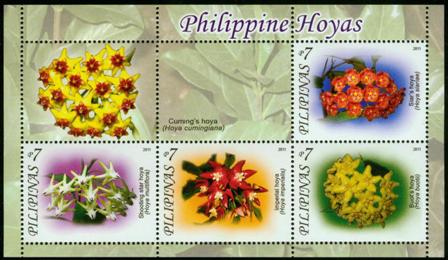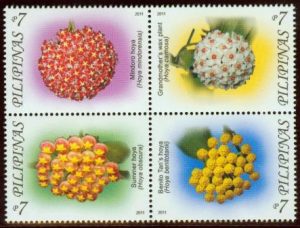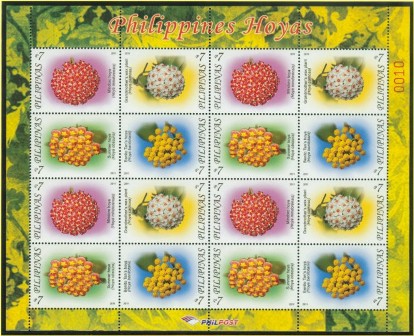Trivia about the Topicals Philippine Hoyas
Hoya. A genus of 200-300 species of tropical climbing plants. Common names for this genus are waxplant, waxvine, waxflower or simply hoya. This genus was named by botanist Robert Brown, in honour of his friend, botanist Thomas Hoy. They are evergreen climbing vines or shrubs growing to 1-10 m (or more with suitable support in trees). They have simple opposite leaves 5-30 cm long that are typically succulent, and in many species are flecked with irregular small silvery spots. Each flower is about 1 cm diameter, with five thick, waxy, triangular petals; colours range from white to pink or yellow. They are sweetly scented and produce abundant nectar. (http://en.wikipedia.org/wiki/Hoya)
Mindoro Hoya (Hoya Mindorensis). A red flowered Hoya mindorensis Schltr. 1906 has been found in the year 1905 at the island of Mindoro, Philippines and has been named by the German botanist Rudolf Schlechter. Hoya mindorensis plants are available in various colours, like pink, red, yellow and white. (http://www.orchids-flowers.com/category/tropical-flowers/hoya-wax-flower/page/2/)
Grandmother’s Wax Plant (Hoya Carnosa). One of 100 species of Hoya that are native to Eastern Asia and Australia. The common houseplant Hoya carnosa was named for Thomas Hoym, gardener to the Duke of Northumberland at the end of the 18th century. Clusters of attractive, star shaped, pink-white blossoms are produced in summer. The delicate flowers appear to be made of porcelain and are truly unique. Hoya carnosa can be propagated at anytime by air layering or by stem cuttings. A portion of the stem including one or more pairs of leaves will quickly produce roots in water or damp sand. (http://www.plantoftheweek.org/week029.shtmln)
Summer Hoya (Hoya Obscura). A fast growing hoya from the Philippines. Characterized by medium-sized veined leaves that range from deep green when grown in shade, to a deep reddish color when grown in sunlight. Growing habit: Viny and compact, leaves fairly close together along new shoots. Very fast grower in optimal conditions. Leaf size is 2 cm to 10 cm. Its fragrance is intense and pleasant. (http://en.wikipedia.org/wiki/Hoya_obscura)
Benito Tan’s Hoya (Hoya Benitotanii). Golden yellow flowers, 20-30 in the flat umbel; glossy green leaves on a medium vine. Originated from the Philippines. Named after Dr. Benito Tan, renowned and respected botanical expert.
Siar’s Hoya (Hoya Siariae). Originates from the Philippines. It is named in honour of Dr. Simeona Siar, a researcher at the Institute of Plant Breeding, College of Agriculture and Arts and Sciences, Philippines. The flowers are cup shaped and about 1.2 cm in diameter. The color is a strange pink, almost transparent. The corona is darker pink with a yellow center. There is anything from 10 to 25 flowers in an umbel. The flowers only last a couple of days.
Hoya Multiflora (Shooting Stars). A scandent plant with very unique blooms of waxy texture. The clusters of yellow and white flowers are arranged like a shooting stars display. This species has inflorescences in the form of umbrellas, but they are composed of dozens of highly fragrant flowers. Partially concealed by green leaves with a length of 10 cm, although its stems are very strong.
Imperial Hoya (Hoya Imperialis). Hoya imperialis will produce some of the largest individual flowers of the Hoya group. It is a large vine compared with other Hoyas. The leaves are green and about 4″ long by 2″ wide and the stems can each reach lengths of more than 4″. It will produce clusters of burgundy flowers with white in the center mainly during the warm weather. They are quite easy to grow like the other Hoyas, but sometimes their mature size can be a problem for people with limited space. (http://www.rareflora.com/Hoyaimperialis.html)
Buot’s Hoya (Hoya Buotii). an outstanding white or light yellow Hoya wax flower, native to the Philippines. D. Kloppenburg named the Hoya buotii species in honour of the Philippine botanist Inocentio Buot Jr. An easy to handle plant, which loves a sunny place and even young plants are flowering. Emits a nice, but not very strong, vanilla-like fragrance. (http://www.orchids-flowers.com/tropical-flowers/hoya-buotii-hoya-halconensis-white-wax-flower/)
According to PCARRD-DOST website, “Hoya, commonly called wax plant, belongs to the Asclepiadaceae family. They are once part of the Apocinaceae family. In the Philippines, hoyas can be found all over the islands at all altitudes. As early as 1837, Philippine Hoyas was mentioned in the publication of Flora de las Islas Filipinas. To date there are 51 species which have been identified.”
Photos and Philippine Hoya species provided for by Mr. Fernando B. Aurigue, Science Research Specialist and Project Leader, Agricultural Research Section, Atomic Research Division, Philippine Nuclear Research Institute (PNRI).



Recent Comments